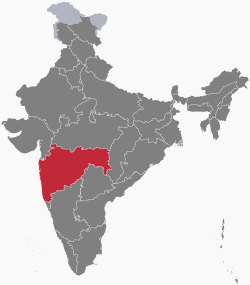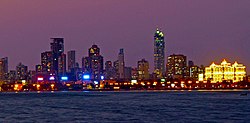Maharashtra
Maharashtra is a state in Western India. Its language is Marathi. It is the third biggest state of India by area and second biggest state in India based on population. Only one Indian state has more people (Uttar Pradesh). Mumbai is the capital of Maharashtra. Pune is the cultural and educational capital.
|
महाराष्ट्र | |
|---|---|
State of India | |
 Location of Maharashtra in India | |
 Map of Maharashtra | |
| Country | |
| Region | West India |
| Area | |
| • Total | 307,713 km2 (118,809 sq mi) |
| Population (2011) | |
| • Total | 112,374,333[1] |
| Time zone | UTC+05:30 (IST) |
Geography
Maharashtra is in the west part of India. It is on the coast of the Arabian Sea. Six other states of India have borders with Maharashtra. It covers an area of 118,530 square miles (307,000 square kilometres). It is bigger than Italy, but smaller than Oman. In traditional Indian geography it falls under the West Indian zone.
Maharashtra has more business than any other state of India.[source?]
There are some well-known cave monuments like Ajanta and Ellora. Some of the crops grown in Maharashtra are Bajra, Jowar, Rice, Wheat, etc. The neighbouring States are Gujarat, Madhya Pradesh, Telangana, Karnataka, Goa, and Chhattisgarh. Some of the famous food dishes in Maharashtra are Pav Bhaji, Vada pav, Misal pav, etc.
Culture
As per the 2011 India census, Around 79% of people in Maharashtra are Hindus,[2] therefore Hinduism forms a major link in the culture of Maharashtra. There are many temples in Maharashtra and some of them are very old. The architecture of these temples is a mixture of architecture from North and South India. The temples also have ideas from Hindu, Buddhist and Jain cultures. Maharashtra has many forts like Raigad and Pratapgad which were very important in the early history of the Maratha Empire and also sea forts like the one at Sindhudurg. A famous dance form in Maharashtra is lavani.[source?] Maharashtra is split into five areas: Konkan, Paschim Maharashtra, Northern Maharashtra, Marathwada, and Vidarbha.[3] Each of these regions has its own unique culture, including various dialects of the Marathi language, traditional songs, cuisine, clothing, and people.
Music
The folk music of Maharashtra is mixed.
An early piece of Marathi literature is Bhawarthadeepika (known as Dnyaneshwari) by Dnyaneshwar. The religious songs called bhajans by Dnyaneshwar, Tukaram, Namdev,chokhamela,Savta Mali are very popular. Modern Marathi literature also has some great poets and authors like Jyotirao Govindrao Phule, Savitribai Jyotirao Phule, Dr.Bhimrao Ramji Ambedkar, Anna Bhau Sathe, Namdev Dhasal, M.M. Deshmukh, P. L. Deshpande, Kusumagraj, Prahlad Keshav Atre and Vyankatesh Madgulkar. Many books are published every year in Marathi.
The theater, movies, and television in Maharashtra are mostly made in Mumbai, and the actors in each area (like television) can work in the others. Some important people in the movie industry are Dadasaheb Phalke, Dada Kondke, Ashok Saraf, Laxmikant Berde, Sachin Pilgaonkar, Mahesh Kothare and V. Shantaram. Early Marathi theatre had important playwrights (people who write plays) like Kolhatkar, Khadilkar, Deval, Gadkari and Kirloskar. They wrote musical plays called Sangeet Naatak. The music from those plays is called Natyasangeet. Important actors at this time were Bal Gandharva, Keshavrao Bhosle, Bhaurao Kolhatkar, and Dinanath Mangeshkar.
Some of the popular Marathi television channels are Mi Marathi and ETV Marathi. They have many kinds of shows: soap operas, cooking, travel, political satire, and game shows.
Food and games
The food of Maharashtra is different in each place. The people in the Konkan region eat more rice and the ones near the ocean eat a lot of fish. In eastern Maharashtra, most people eat a lot of wheat, jowar, and bajra. Other important things people eat in Maharashtra are lentils, onions, tomatoes, potatoes, chilies, garlic, ginger, and aamras. Many people also eat chicken and mutton.
In the past, women wore a long sari (Nauvari saree) and men wore a dhoti or pajama with a shirt. Today, women in the cities often wear other clothes like Salwar kameez (dresses from the Punjab), and men in the cities wear trousers and a shirt.
Cricket is very popular in Maharashtra. Many people play it and many others watch it. Kabaddi is also popular. Children play Viti-Dandu and Pakada-pakadi (Tag).
Hindus in Maharashtra follow the Saka era calendar. Gudi Padwa, Diwali, Rangapanchami, Gokulashtami, and Ganeshotsav are some of the festivals that are celebrated in Maharashtra. Ganeshotsav is the biggest festival. Hindus celebrate it with reverence and festivity in Maharashtra and it has also become popular in other parts of India. The festival which lasts ten days is in honor of Ganesha, the Hindu god of learning and knowledge.
Provincial symbols of Maharashtra
National parks
There are some national park as:
- Chandoli National Park (2004), Chandoli National Park is natural World Heritage Site and 317.67 km² National Park spread overSatara, Kolhapur and Sangli District, Maharashtra state, India, established in May 2004. Earlier it was a Wildlife Sanctuary declared in 1985
- Gugamal National Park (1975), has an area of 1673.93 square kilometers. Built in 1974, this park is in Chikhaldara and Dharni Tehsils of Amravati District, Maharashtra, India. It is part of Melghat Tiger Reserve.
- Navegoan National park (1975), Navegaon National Park is a national park in the Gondia district of Maharashtra, India. Navegaon, a popular forest resort in the Vidarbha region, the easternmost part of Maharashtra, was built in the 18th century
- Sanjay Gandhi (Borivilli) National Park (1983), Sanjay Gandhi National Park, formerly Borivali National Park, is a large protected area in the northern part of Mumbai city in Maharashtra State in India. Address: Mumbai, Maharashtra 400101 Area: 103.8 km²
- Todoba National Park (1955), Tadoba Andhari Tiger Reserve is a tiger reserve in Chandrapur district of Maharashtra state in central India. It is notable as Maharashtra's oldest and largest national park. It is one of India's 50 "Project Tiger" - tiger reserves. Area: 625.4 km²
Maharashtra Media
A Bengal tiger in Tadoba Andhari Tiger Reserve
Mantralaya or administrative headquarters of Maharashtra state government in South Mumbai
The Bombay High Court, one of the oldest high courts in India
Freshly grown sugarcane. Agriculture is the second leading occupation in Maharashtra.
Students at a state-run primary school in Raigad district
References
- ↑ "Maharashtra Population 2011 - 2022". www.census2011.co.in. Retrieved 2022-03-06.
- ↑ "Maharashtra Population". www.census2011.co.in. Retrieved 2023-09-27.
- ↑ "Divisions and Regions of Maharashtra". www.discoveredindia.com. Archived from the original on 2014-02-02. Retrieved 2023-09-27.
Other websites
| Wikimedia Commons has media related to Lua error in Module:Commons_link at line 62: attempt to index field 'wikibase' (a nil value).. |
| Wikivoyage has a travel guide about: Maharashtra |
- Maharashtra -Citizendium













